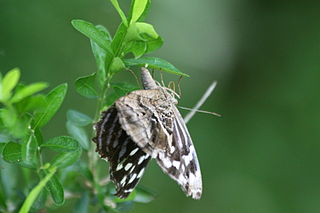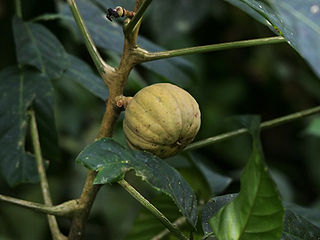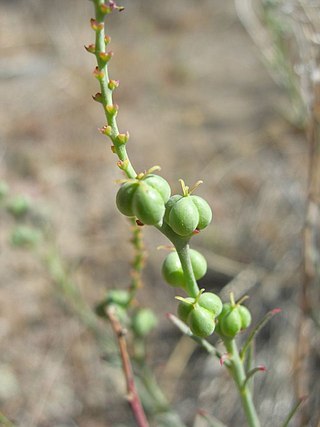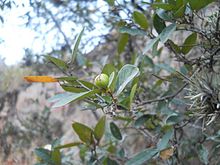
Antidesma is a genus of tropical plant in the family Phyllanthaceae formally described by Linnaeus in 1753. It is native to tropical Africa, S + E + SE Asia, Australia, and various oceanic islands. The greatest diversity occurs in Southeast Asia.

Phyllanthus is the largest genus in the plant family Phyllanthaceae. Estimates of the number of species in this genus vary widely, from 750 to 1200. Phyllanthus has a remarkable diversity of growth forms including annual and perennial herbs, shrubs, climbers, floating aquatics, and pachycaulous succulents. Some have flattened leaflike stems called cladodes. It has a wide variety of floral morphologies and chromosome numbers and has one of the widest range of pollen types of any seed plant genus.

Macaranga is a large genus of Old World tropical trees of the family Euphorbiaceae and the only genus in the subtribe Macaranginae. Native to Africa, Australasia, Asia and various islands of the Indian and Pacific Oceans, the genus comprises over 300 different species. It was first described as a genus in 1806, based on specimens collected on the Island of Mauritius.
Discoclaoxylon is a plant genus of the family Euphorbiaceae, first described in 1914. It is native to western and central Africa, including islands in the Gulf of Guinea.
- Discoclaoxylon hexandrum(Müll.Arg.) Pax & K.Hoffm. - Ghana, Guinea, Ivory Coast, Sierra Leone, Nigeria, Cameroon, Gabon, Central African Republic, Equatorial Guinea, São Tomé, Congo-Brazzaville, Zaire, Uganda
- Discoclaoxylon occidentale(Müll.Arg.) Pax & K.Hoffm. - São Tomé
- Discoclaoxylon pedicellare(Müll.Arg.) Pax & K.Hoffm. - Bioko
- Discoclaoxylon pubescens(Pax & K.Hoffm.) Exell - Annobón

Adelia is a genus of flowering plants in the spurge family, Euphorbiaceae, subfamily Acalyphoideae. It is native to Latin America and the Caribbean, with one species extending northward into the southernmost part of Texas.
Discocleidion is a plant genus of the family Euphorbiaceae first described as a genus in 1914. It contains one accepted species, Discocleidion rufescens, endemic to China.

Argythamnia is a genus of plants of the family Euphorbiaceae first described as a genus in 1756. They are known commonly as silverbushes.

Epiprinus is a genus of plant of the family Euphorbiaceae first described as a genus in 1854. It is native to Indochina, Sumatra, southern China, and the Indian Subcontinent.
- Epiprinus balansae(Pax & K.Hoffm.) Gagnep. - Vietnam
- Epiprinus lanceifoliusCroizat - Vietnam
- Epiprinus malayanusGriff. - Myanmar, Thailand, Peninsular Malaysia, Sumatra
- Epiprinus mallotiformis(Müll.Arg.) Croizat - southern India
- Epiprinus poilaneiGagnep. - Vietnam
- Epiprinus siletianus(Baill.) Croizat - Hainan, Yunnan, Assam, Laos, Myanmar, Thailand, Vietnam
Argomuellera is a genus of plant of the family Euphorbiaceae first described as a genus in 1894. It is native to sub-Saharan Africa, Madagascar, and the Comoros Islands.

Tetrorchidium is a genus of flowering plants in the family Euphorbiaceae first described in 1841. It is native to tropical portions of Africa and the Western Hemisphere.

Hura is a genus of trees in the family Euphorbiaceae described by Carl Linnaeus in 1753. It is native to South America, Mesoamerica, and the West Indies.

Manihot is a genus in the diverse milkspurge family, Euphorbiaceae. It was described as a genus in 1754.

Stillingia is a plant genus of the family Euphorbiaceae, first described for modern science as a genus in 1767. The genus is native to Latin America, the southern United States, and various islands in the Pacific and Indian Oceans. Toothleaf is a common name for plants in this genus.
Dalembertia is a plant genus of the family Euphorbiaceae first described as a genus in 1858. It is native to Mexico and Guatemala.
- Dalembertia hahnianaBaill. - México State, Morelos, Michoacán
- Dalembertia platanoidesBaill. - Oaxaca, Guerrero, México State
- Dalembertia populifoliaBaill. - from Sonora to Oaxaca
- Dalembertia triangularisMüll.Arg. - Guatemala, Chiapas, Oaxaca

Gymnanthes is a genus of flowering plants in the spurge family, Euphorbiaceae, first described as a genus in 1788. It is found primarily in the warmer parts of the Western Hemisphere, but with some species in central Africa and southwestern Southeast Asia.
Discocarpus is a genus of the plant family Phyllanthaceae first described as a genus in 1841. It is native to northern South America. It is dioecious, with male and female flowers on separate plants.
- Discocarpus essequeboensisKlotzsch - Brazil, Venezuela (Amazonas), Guyana, Suriname, French Guiana
- Discocarpus gentryiS.M.Hayden - S Venezuela (Amazonas), Peru (Loreto), N Brazil
- Discocarpus pedicellatusFiaschi & Cordeiro - State of Bahia in Brazil
- Discocarpus spruceanusMüll.Arg. - Venezuela (Amazonas), Brazil, Suriname (Sipaliwini), Bolivia

Pausandra is a plant genus of the family Euphorbiaceae first described in 1870. It is native to Central America and South America.
- Pausandra fordiiSecco - Amapá, French Guiana
- Pausandra hirsutaLanj. - Peru, Brazil, Bolivia (Pando), Colombia (Amazonas)
- Pausandra macropetalaDucke - Brazil, Peru (Loreto), Venezuela (Amazonas)
- Pausandra macrostachyaDucke - Pará
- Pausandra martiniBaill. - French Guiana, Suriname, Guyana, Colombia, Venezuela, Peru, Brazil
- Pausandra megalophyllaMüll.Arg. - Rio de Janeiro
- Pausandra morisiana(Casar.) Radlk. - Brazil
- Pausandra trianae(Müll.Arg.) Baill. - widespread from Honduras to Bolivia












